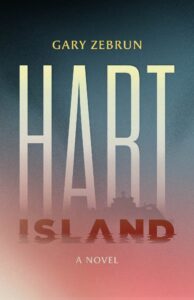A Review of Gary Zebrun’s Hart Island
Hart Island, Gary Zebrun. University of Wisconsin Press, 2024. 192 pages. $17.95
by Scott Hightower
Every once in a while a novel comes along that has remarkable heart, that dares to set out to explore the mysterious ways, dark secrets, and truths of our humanity. Zebrun, then a newspaper man, came across an article about New York City’s Hart Island, he tucked it away in his imagination. He had found his metaphor:
“Once a Civil War prison and training site and later a psychiatric hospital, among other incarnations, Hart Island, just off the coast of the Bronx in the Long Island Sound, eventually became the repository for New York City’s unclaimed dead. The island’s mass graves are a microcosm of New York history, from the 1822 burial crisis to casualties of the Triangle Shirtwaist fire and victims of multiple epidemics.” (Michael Keene, New York City’s Hart Island, a Cemetery of Strangers, The History Press, 2019)
In a time fraught with portrayals of ends of empires, apocryphas, and social dystopias, it is refreshing to be reminded that our day to day existence (light and dark), played out in ancient sceneries, are the real stuff of our humanity (our faith in life), which goes on trial every day.
Zebrun’s characters, far from the pomp and ceremony of the Vatican, are the Italian and Irish working men and women of New York. In the modest homes, watering holes, and places of work and worship one is far more likely to encounter miracles, real discoveries, real forgiveness, real revelation—real creatures in need of nutrition, safety, and, at times, sanctuary. At the center of the tale is Sal Cusumano, daily pilot of the boat that ferries the colorful prison detail that carries out the necessary duties to provide peace for unclaimed New York City souls, young and old alike. (Zebrun’s characters are revealed in various currents of communication.) Complexities arise with Sal’s associations with the mafia, law enforcement, religion, and troughs and trials of intimacy.
The sense of place veers—as on a harbor boat––from the majestic New York City, which seems more an archipelago than a city, to Hart Island, the peaceful final resting place for the lost and unclaimed.
In this exploration of love––in obedience, submission, betrayal, or action–– Zebrun weaves a tale of crime surrounded by the shimmer of law. In the end, his revelations are about forgiveness, not shame. Justice is fluid, as are many of the discovered boundaries of familial hearts that comprise this novel.
The book is written in short, carefully titled scenarios. Zebrun masterfully employs ample suspense; cares deeply for each of his characters. Much of the joy of the read is in Zebrun’s restraint and subtly. I don’t know if a quote or simply a proverb, but I can recall my own writing teacher adjuring me: “The tiny is the last refuge of the tremendous.”
Zebrun’s Hart Island belongs on the shelf with Andre Gide’s The Immoralist.
Scott Hightower is the author of five books of poetry in the US. He has published two bilingual collections in Spain. He is also the editor of the bi-lingual (English/Spanish) poetry anthology 2012 Women Rowing: Mujeres A Los Remos, Mantis Editores, Guadalajara, Mexico.
Hightower’s awards include a Hayden Carruth Book Award and a Barnstone Translation Prize. Originally from Texas, he has itinerantly sojourned in India, Italy, Spain, and now lives in Manhattan where he teaches at NYU’s Gallatin School of Individualized Study. www.Scotthightower.com

